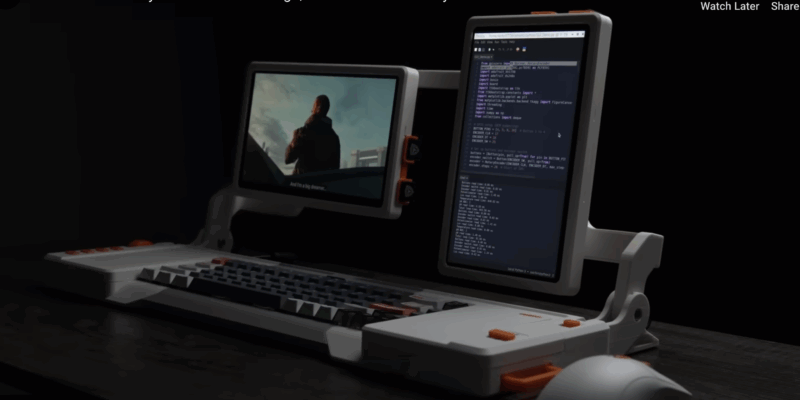Radiation detecting Geiger counter
By David Crookes. Posted

Our initial contact with Dmytro Panin came in August 2021 when we looked at his Air Quality Traffic Light – a project designed to monitor the pollution in the atmosphere of his home city of Kyiv in Ukraine. Never did we ever imagine, little more than a year later, he would be seeking to detect dangerous levels of radiation in the air, but that’s where he finds himself today.
“The vast majority of the projects I build are created out of necessity,” he tells us. “This one, unfortunately, is no exception. With almost daily threats of a nuclear catastrophe at one of our power plants due to Russian shelling or hints of a nuclear strike, some of us started to wonder how to detect an increasing level of radiation if something were to happen.”
Advertisement
The desktop computer you've been waiting for: Raspberry Pi 500+
This prompted him to create a device using a Raspberry Pi Pico W. “Radiation is not something you can feel, see, taste, hear, or smell,” he says. “So, I created a device designed to be a silent observer of the ionising radiation levels in my city. I wanted it to become the sixth missing sense, if you will.”
Keeping count
As well as Raspberry Pi Pico W, the build includes an M4011 Geiger–Müller tube. It’s old technology, for sure – the concept was developed back in 1908 at the University of Manchester and it came into being 20 years later. “But I’ve never had an excuse to work with it, so I took it as a way to improve my knowledge,” Dmytro says. “It may be old, but it’s very important tech.”
At first, he tried to find all the components required to build a rudimentary Geiger counter from scratch before realising it would take him too long to locate everything he needed. “I then came across a pre-built module based on the M4011 which has a digital pin that can relay the tube’s pulse caused by an ionising event,” he continues.
“I configured an interrupt on one of the pins of my Raspberry Pi Pico W so it can listen and ‘remember’ the number of ‘ticks’ that the Geiger tube experiences over a period of time. Based on that, I can interpolate (or sometimes extrapolate) the current CPM (counts per minute).”

Stark warning
Understanding that CPM – while generally accepted and widely used in measuring radiation – doesn’t universally equate to dose rate, he implemented a conversion to sieverts per hour, a unit that allows radiation levels to be expressed. “Fortunately for me, DFRobot, the creator of the module, had an easy conversion formula for M4011,” Dmytro says. “So I decided to use that.”
Dmytro has placed the device next to a window in his apartment and it’s connected to an OLED screen so that he can keep an eye on the current radiation level. It’s also possible to check the device from afar.
“Raspberry Pi Pico W can push the readings to a server every few hours so I can keep track of what’s happening with the ionising radiation levels even if I’m not home,” he explains. “But, unfortunately, due to the power blackouts we’re having, the readings are not updated very often as I don’t keep the device plugged in any more.”
So far, the device has been showing around 25 CPM. “That’s what you expect from a tube like this in a ‘normal’ environment,” Dmytro says. “As for what reading would indicate a problem, well, I hope we won’t need to learn this,” he says. “But, overall if the readings are drastically higher than what they are at the moment, I’d interpret it as a problem that requires more thorough investigation.” Fingers crossed it never comes to that.
Subscribe to Raspberry Pi Official Magazine
Save up to 37% off the cover price and get a FREE Raspberry Pi Pico 2 W with a subscription to Raspberry Pi Official Magazine.
More articles

Raspberry Pi 500+ in Raspberry Pi Official Magazine issue 158
We’re quite taken with Raspberry Pi 500+. But when you don’t need all that processing power, and just want a board that will make a plastic skeleton jump around in a terrifying manner, you’ll find Raspberry Pi Pico more than up to the job. There’s more terror in the magazine (which is only right as […]
Read more →

Win one of five Raspberry Pi SSD 1TB
Raspberry Pi prides itself on high quality hardware, and this 1TB Raspberry Pi SSD is no different. You can use it with a standard Raspberry Pi or even in your desktop PC – the choice is yours. We have five to give away and you can enter below Win 1 of 5 Raspberry Pi SSD […]
Read more →

Dual-screen cyberdeck
Twin screens mean you can code on one screen while watching David Bowie’s 1978 Musikladen show on the other.
Read more →
Sign up to the newsletter
Get every issue delivered directly to your inbox and keep up to date with the latest news, offers, events, and more.
